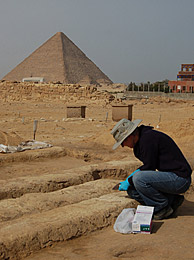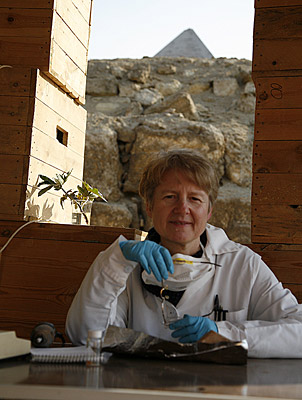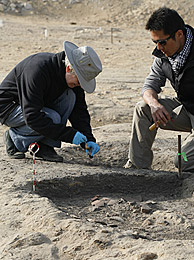Posted by Valerie Steele

Sampling plaster from the Hypostyle Hall
I arrived in Giza in the early hours of Monday morning on my first visit to Egypt. I never imagined I would visit the pyramids and yet here I am, not just visiting but doing a job I really enjoy right next to a pyramid (actually two)! What am I doing here?
My work involves looking at the organic residues that have been preserved in ancient pottery. These residues are the degraded remains of plant or animal material – everything from food and drink to cosmetics, medicines, waterproofing materials, glues, dyes and, elsewhere, even Neolithic chewing gum made from birch bark.
Pottery is a great place to look for these materials because unglazed pottery is full of holes like a sponge so anything liquid inside the pot tends to soak into these pores. Once inside organic material is semi-protected from the effects of water, sunlight, bacteria, air – in fact most things that might degrade them.
Of course over long periods of time some materials do degrade or disappear. For example sugars and starches are very soluble in water and easily get washed away during burial while proteins are easily broken down by bacteria and rarely survive. The best preserved materials, hence the ones we are most likely to find, are fats, waxes, substances like pitch and tar, sterols (think cholesterol) and other complex compounds like tannins (as in tea) and some dye compounds.
My work involves extracting residues from pottery with solvents, analysing them using chromatographic techniques (to separate complex mixtures of compounds) and mass spectrometry (to identify the compounds present) and then comparing them with modern materials to see if I can identify what was originally in the cooking pot, bottle, jar etc. I obtain these residues by taking small samples of pottery and plaster. These will remain in the Laboratory at Giza until the analysis can be arranged.

Val sampling pottery at the Lab
This may sound like intellectual curiosity but it can be a very powerful technique for looking into the lives of people in the past. For example looking at people’s cooking pots can tell us what they were eating, finding out what was traded in a particular type of flask give us new information about industry and trade relationships, and cosmetic jars and bottles can give us an insight into what people were putting on their faces.
It has its limitations of course. For example plant material can be quite hard to detect as many plants don’t contain much in the way of fats or waxes. It’s also hard to identify the origin of degraded fats and oils as they all look very similar after a few hundred years, although isotopic techniques developed in the 1990s do allow us to distinguish cow and sheep/goat meat from pig fat, milk and oily fish.

Sampling plaster from SFW-House Unit 1
So specifically what am I doing in Giza? I’m here to investigate some of the continuing questions at the site using residue analysis to address these queries. For example, identifying the contents of vessels from the Pedestal Building in area AA might give us some idea what was going on in there. Sampling the plaster floors in other areas of the building might reveal whether the bin-like structures were for malting. The identification of malting using organic residues would be a world first and it may not be possible, but it would be exciting to try. Also were beer jars really for beer (a bit harder to do that one as beer is tricky to identify) and were the large vessels found in bakeries actually for mixing bread (also quite hard to identify but worth a try)? Answering these questions would give us a unique insight into the lives of the people who lived and worked at this site 4,500 years ago, which is, after all, what archaeology is all about. So the future is potentially very exciting and I shall leave at the end of the week with many possibilities to think over as well as the great experience of visiting Egypt for the first time.
